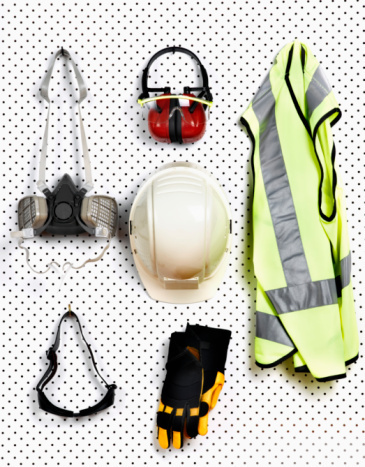Written by Michael Tobias
The Occupational Safety and Health Administration (OSHA) publishes and enforces standards to ensure safety and health in the workplace. OSHA has existed since 1970, and it is part of the US Department of Labor. The organization also conducts training and public outreach, to implement workplace safety standards more effectively.
The construction industry involves work at height, direct exposure to weather conditions, and heavy equipment. Considering these conditions, it should come as no surprise that construction is among the business sectors with the most accidents.
When risk management is given high priority in
construction administration, the chance of workplace accidents is reduced. According to OSHA, most workplace accidents in the construction industry involve the risk factors listed below.
- Falls
- Excavation collapses
- Electrical accidents, such as electric shock or arc flash
- Lack of personal protection equipment, or incorrect use
- Accidents caused by machinery, especially cranes and forklifts
This article provides an overview of several construction hazards, along with OSHA recommendations to manage them. The content is informative, and not intended to be used instead of the corresponding OSHA standards.
Fall Prevention
Falls can be considered the main workplace risk in construction, accounting for the largest share of injuries and fatalities reported each year by OSHA. Having reliable work platforms is critical to prevent falls, combined with additional safety measures such as body harnesses.
Many falls in construction sites are related with improper use of scaffolding and ladders, and OSHA provides the following recommendations when working with them:
- Scaffolds must be capable of bearing their own weight plus four times the intended load, without displacement or deformation. They must also be assembled on a stable surface, avoiding unreliable supports like bricks or barrels.
- Scaffolds must not be used if any of their safety accessories are missing, and damaged parts should be replaced immediately. If synthetic or natural ropes are used, they must be kept away from heat sources.
- In general, scaffolds should only be handled under the supervision of a qualified person, and they should never be used less than 10 feet away from power lines.
- Ladders must have an adequate length for the task and should not be used under any circumstances if they are damaged or unstable.
- The load bearing capacity of ladders must never be exceeded, and the use of metallic ladders should be avoided close to live conductors or power lines.
Partially built stairways can also be dangerous for construction personnel. The risk of falls is increased when stairs are wet or covered with debris, and also if their handrails have not been installed yet.
Trench Collapse Prevention
Material collapse is the main risk when working in excavations or trenches, since it can bury construction workers and equipment. OSHA provides several safety guidelines to prevents accidents of this type:
- Trenches at least 5 feet deep must have a protective system, unless the excavation work is being performed on stable rock.
If the trench depth is at least 20 feet, the protective system must follow be designed by a registered professional engineer. - Construction workers should never enter an unprotected trench.
Personnel inside the trench must always have an exit available less than 25 feet away. - OSHA specifies a minimum slope angle for each soil material.
Materials and equipment should never be placed at the edge of an excavation, since they can cause an accident by falling into the trench.
Preventing Electric Shock and Arc Flashes
When working with electricity at a construction site, there are two main hazards. Energized conductors represent a risk of electric shock by themselves, and arc flashes can also cause injuries due to the force of the explosion. To prevent these types of accidents, OSHA provides the following recommendations:
- Using Lockout/Tagout properly and avoiding any work that involves live conductors or energized equipment parts.
- Technical personnel should never use electrical cords that are damaged, or without a grounding prong. Tools and equipment that show electrical faults should be removed from service and repaired or replaced.
- Temporary power supplies should be clearly indicated, and multiple plug adapters should be avoided.
As previously mentioned, construction equipment and materials should never be placed or used less than 10 feet away from power lines. Note that OSHA specifies even greater clearances as the rated voltage of power lines increases.
Adequate Use of Personal Protection Equipment
Many accidents in construction sites can be prevented with personal protection equipment. Hard hats should be used at all times, since the risk of falling objects or bumping into fixed objects is present in all project sites. Hard hats should be checked at regular intervals, and replaced if they can no longer offer protection due to damage.
Hard hats should be complemented with safety footwear, and personnel should also wear adequate gloves and face protection when required for a specific task. High-visibility clothing should also be worn, so that construction workers can be easily distinguished from the background.
Operating Heavy Equipment Safely
Heavy equipment can easily injure construction workers due to its sheer weight, and most equipment accidents are associated with cranes and forklifts, according to OSHA.
Cranes should only be operated by qualified personnel, staying away from power lines at all times. A crane should never exceed its rated load capacity, and a load chart should be displayed where it can be easily seen by the operator. Crane operation should adhere to strict guidelines, and construction workers must stay outside of the swing radius when the crane is operating.
Forklifts may seem less threatening than cranes due to their compact size, but they also cause many accidents. Forklifts should only be used by qualified operators and for project activities, never for stunts or playing. The load should never exceed the rated capacity, and the vehicle should not be modified in ways that are not approved by the manufacturer. Forklifts should always use adequate battery chargers, avoiding improvised connections.
The Importance of Effective Communication
Construction risks are present even when prevention measures are in place, and communication is very important to ensure safe practices. Project managers can mitigate risks drastically when construction workers are well informed and trained.
The Project Management Body of Knowledge (PMBOK) dedicates a whole chapter to risk management, considering its importance for project success. Risk prevention has a much lower cost than repairing the damage caused by construction accidents, and it protects the life and health of construction personnel.
Michael Tobias is the founder and principal of
Chicago Engineers. He is a graduate of Georgia Tech class of 2004, with a Bachelors of Mechanical Engineering with honors. His innovative approach to MEP engineering comes from graduating GE’s Engineering Leadership Program, where he designed wind turbines and biofuel power plant engines. Michael’s passion within design is energy efficiency and green technology.
to
Michael Tobias PE, LEED AP, CEM
Principal
New York Engineers
135 W 41st Street, 5th Floor
New York, NY 10036
212.575.5300

